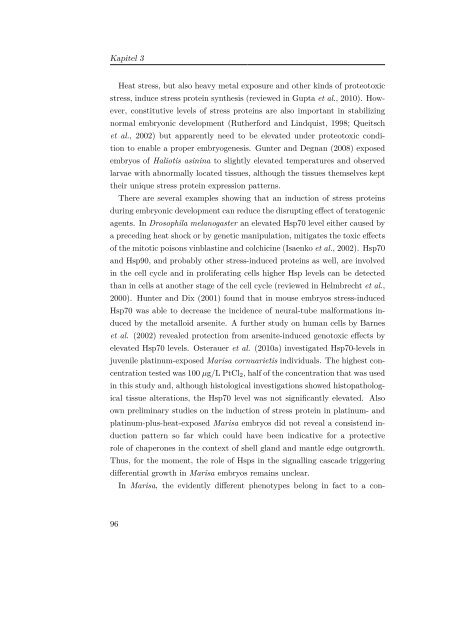Die Embryonalentwicklung der Paradiesschnecke ... - TOBIAS-lib
Die Embryonalentwicklung der Paradiesschnecke ... - TOBIAS-lib
Die Embryonalentwicklung der Paradiesschnecke ... - TOBIAS-lib
Create successful ePaper yourself
Turn your PDF publications into a flip-book with our unique Google optimized e-Paper software.
Kapitel 3<br />
Heat stress, but also heavy metal exposure and other kinds of proteotoxic<br />
stress, induce stress protein synthesis (reviewed in Gupta et al., 2010). However,<br />
constitutive levels of stress proteins are also important in stabilizing<br />
normal embryonic development (Rutherford and Lindquist, 1998; Queitsch<br />
et al., 2002) but apparently need to be elevated un<strong>der</strong> proteotoxic condition<br />
to enable a proper embryogenesis. Gunter and Degnan (2008) exposed<br />
embryos of Haliotis asinina to slightly elevated temperatures and observed<br />
larvae with abnormally located tissues, although the tissues themselves kept<br />
their unique stress protein expression patterns.<br />
There are several examples showing that an induction of stress proteins<br />
during embryonic development can reduce the disrupting effect of teratogenic<br />
agents. In Drosophila melanogaster an elevated Hsp70 level either caused by<br />
a preceding heat shock or by genetic manipulation, mitigates the toxic effects<br />
of the mitotic poisons vinblastine and colchicine (Isaenko et al., 2002). Hsp70<br />
and Hsp90, and probably other stress-induced proteins as well, are involved<br />
in the cell cycle and in proliferating cells higher Hsp levels can be detected<br />
than in cells at another stage of the cell cycle (reviewed in Helmbrecht et al.,<br />
2000). Hunter and Dix (2001) found that in mouse embryos stress-induced<br />
Hsp70 was able to decrease the incidence of neural-tube malformations induced<br />
by the metalloid arsenite. A further study on human cells by Barnes<br />
et al. (2002) revealed protection from arsenite-induced genotoxic effects by<br />
elevated Hsp70 levels. Osterauer et al. (2010a) investigated Hsp70-levels in<br />
juvenile platinum-exposed Marisa cornuarietis individuals. The highest concentration<br />
tested was 100 µg/L PtCl 2 , half of the concentration that was used<br />
in this study and, although histological investigations showed histopathological<br />
tissue alterations, the Hsp70 level was not significantly elevated. Also<br />
own preliminary studies on the induction of stress protein in platinum- and<br />
platinum-plus-heat-exposed Marisa embryos did not reveal a consistend induction<br />
pattern so far which could have been indicative for a protective<br />
role of chaperones in the context of shell gland and mantle edge outgrowth.<br />
Thus, for the moment, the role of Hsps in the signalling cascade triggering<br />
differential growth in Marisa embryos remains unclear.<br />
In Marisa, the evidently different phenotypes belong in fact to a con-<br />
96
















